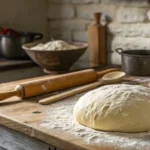
neapolitan pizza dough recipe quick
This quick, authentic Neapolitan pizza dough recipe delivers a light, airy base perfect for homemade pizzas. Enjoy a harmonious blend of quality 00 and all-purpose flours, creating a delicious crust.
Servings 4 servings
Calories 250kcal
Ingredients
00 Flour:
- Use 00 flour for its fine texture and low protein content. It creates a light and airy dough that cooks evenly. If you prefer a different texture you may blend it with all-purpose flour.
All-Purpose Flour:
- A small amount of all-purpose flour can be used to adjust the dough’s consistency if needed. It works well with 00 flour and helps in achieving the right balance for kneading.
Active Dry Yeast:
- Active dry yeast is essential to help the dough rise. Make sure the yeast is fresh for the best performance. This ingredient is crucial for a quick pizza dough recipe.
Water:
- Use lukewarm water to activate the yeast. The water temperature is important; it should be warm enough to help the yeast work but not too hot to kill it.
Salt:
- Salt adds flavor to the dough. It enhances the taste of the pizza dough without overpowering the other ingredients.
Olive Oil:
- Olive oil contributes to a tender dough and adds a rich flavor. It also helps to improve the texture of the crust.
Instructions
Step 1: Preparing the Ingredients
- Measure the Flour:
- Combine 00 flour and all-purpose flour in a large mixing bowl. The blend of these flours is key to creating a soft yet structured dough.
- Activate the Yeast:
- In a small bowl, dissolve active dry yeast and a pinch of sugar in lukewarm water. Stir gently and let the mixture sit for about 5 minutes. The yeast should begin to bubble, which means it is active and ready to work.
- Mix Salt and Olive Oil:
- Add salt directly to the flour mixture. Drizzle olive oil over the flour. These ingredients contribute to the dough’s flavor and texture.
Step 2: Combining the Ingredients
- Make a Well in the Flour:
- Create a small well in the center of the flour mixture. Pour the activated yeast and water mixture into the well.
- Mix Slowly:
- Use a spoon or your hands to mix the ingredients. Gradually combine the flour with the liquid until you form a sticky mixture.
Step 3: Kneading the Dough
- Knead the Dough:
- Transfer the mixture onto a lightly floured surface. Begin to knead the dough by pressing it with the heel of your hand. Fold the dough over itself and push it down. Continue this process for about 8-10 minutes. The dough should become smooth and elastic as you work it.
- Check the Texture:
- The dough should feel soft yet firm enough to hold its shape. It will develop gluten, which is crucial for a good crust. A well-kneaded dough will have a slight tackiness but will not stick excessively to your hands or the surface.
Step 4: First Rise
- Place the Dough in a Bowl:
- Once kneading is complete, form the dough into a ball. Place it in a lightly oiled bowl. Turn the dough ball so that every surface is coated with a thin layer of olive oil.
- Cover the Dough:
- Cover the bowl with plastic wrap or a clean kitchen towel. Let the dough rise in a warm place. This rise should take about 1 hour. The dough should double in size, which indicates that the yeast has worked effectively.
- Room Temperature Considerations:
- Make sure the dough is left in a room with a steady temperature. Avoid placing it in a cold area as this can slow down the rise.
Step 5: Shaping the Dough
- Prepare the Surface:
- After the dough has risen, gently punch it down to remove excess air. Transfer it to a floured surface and divide it into portions if you plan to make more than one pizza. Each portion should form a dough ball.
- Stretch the Dough:
- Using your hands, begin to stretch the dough into a round shape. Work from the center outwards, leaving a slightly thicker edge for the crust. The goal is to achieve a balance between a thin, crisp base and a soft, airy crust.
- Preheat the Oven:
- If you plan to bake the pizza in a home oven, preheat it to the highest setting. For an extra touch, use a pizza stone if available. A hot oven ensures that the pizza cooks quickly and evenly.
Step 6: Final Preparations
- Add Your Toppings:
- Once your dough is shaped, you can begin to add your favorite toppings. Whether you choose a classic tomato sauce, fresh mozzarella, and basil or a more creative combination, make sure the toppings are spread evenly.
- Baking the Pizza:
- Transfer the dough onto the preheated pizza stone or a baking sheet. Bake the pizza until the crust turns golden and the toppings are cooked through. The high heat of the oven helps to set the crust quickly, preserving the texture of the dough.
- Cooling and Serving:
- Once the pizza is baked to perfection, remove it from the oven and let it cool for a few minutes. This resting time allows the crust to firm up slightly, making it easier to cut and serve.
Notes
Nutrition Information (per serving)
- Calories: 250 kcal
- Total Fat: 7 g
- Protein: 8 g
- Carbohydrates: 45 g
- Fiber: 2 g
- Sodium: 400 mg
Note: Values are approximate and may vary with ingredient variations.